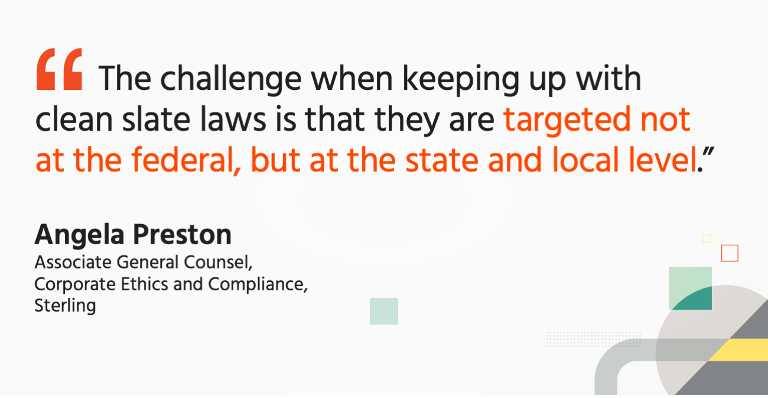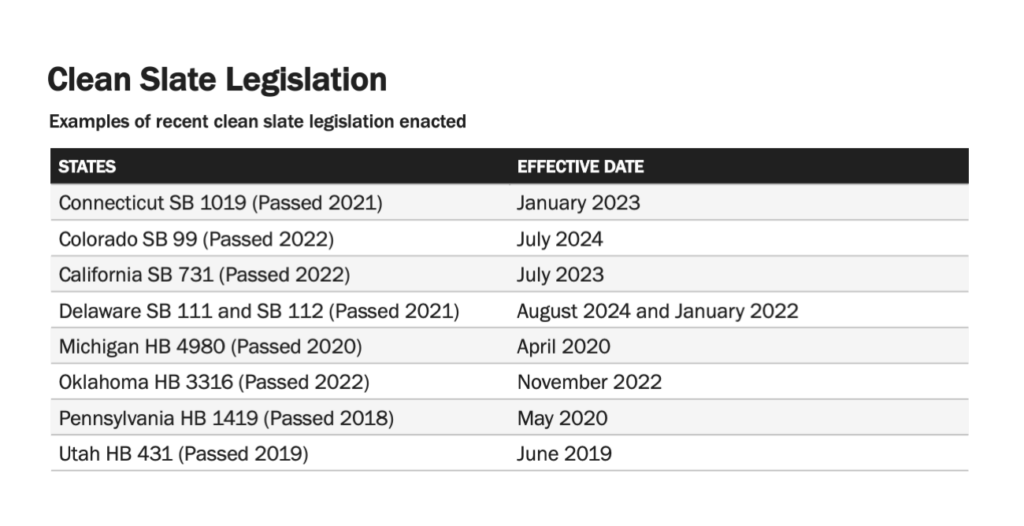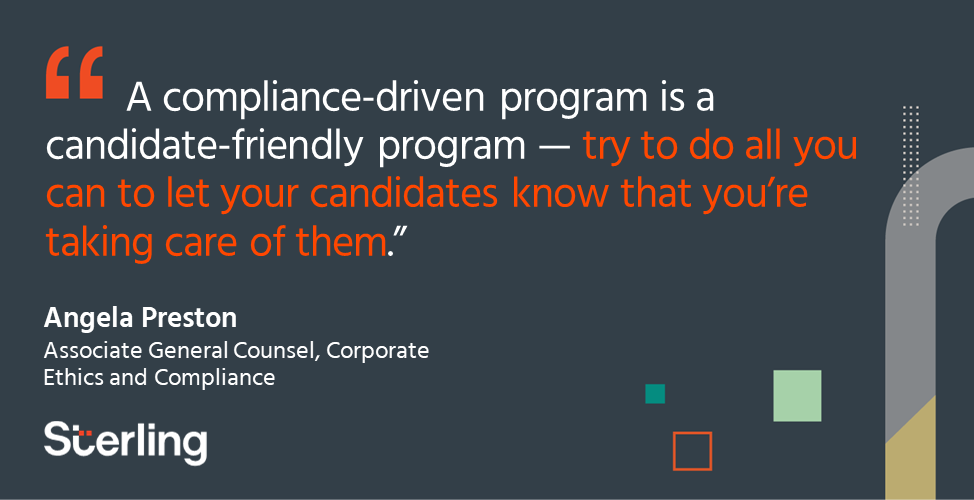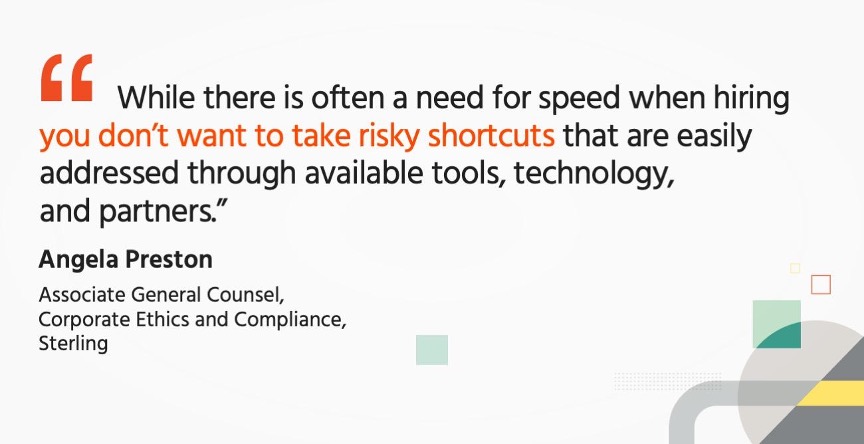July 24th, 2023 | Sterling
Regulatory Recap: Answers to Your Top Compliance Questions

Hiring laws for background screening have rapidly evolved in just the last few years, and now HR teams are finding it challenging to keep up. With background check regulations changing constantly, there’s a lot of complexity in this area of the law. What are successful organizations doing to stay compliant and informed of current best practices in the hiring process and background screening?
In Sterling’s latest webinar, “Hiring and Background Screening Regulations Are Evolving: What You Need to Know to Keep Up,” we partnered with SHRM to share background check compliance best practices and answer our audience’s questions on the topic. The webinar was led by Sterling’s Angela Preston, Associate General Counsel, Corporate Ethics and Compliance. Angela has expertise in all matters relating to hiring compliance, having focused her legal career on background screening and worked in a legal and government relations capacity for 20-plus years.
During the webinar, Angela shared her valuable compliance insights relating to hiring and background screening, including fair chance, clean slate, drug testing, and more. She also unveiled findings taken from Sterling’s own research, our benchmark Hiring Reimagined report.
Let’s cover the top recommendations while answering popular questions from our Q&A session with our audience of HR and compliance professionals.
Hiring Considerations for Compliance with Fair Chance and Clean Slate Laws
Sterling’s Hiring Reimagined report surveyed more than 1,200 HR professionals on the state of hiring, background screening, and the candidate experience. According to Sterling’s original research:
- 73% of HR professionals say they anticipate it will become increasingly challenging to keep up with changes in hiring regulations and practices over the next two years.
- Almost half (47%) believe that over the next two years, their background screening process will become more thorough.
Q: What are “clean slate” laws?
A: Angela explained that “clean slate” refers to a legislative policy model designed to provide relief for individuals with criminal record history, allowing them to have their criminal records expunged or sealed from public record systems. She explains that the main purpose of these laws is to eliminate barriers to employment and housing, restore civil rights, and provide opportunities to help those eligible for criminal record relief.
“Clean slate laws have many variations, and also have a crossover relationship with ‘ban the box’ and fair chance laws. The challenge when keeping up with clean slate laws is that, as far as US compliance is concerned, these laws are targeted not at the federal, but at the state and local level.”

Here are some of the recent laws that have been enacted:

Angela shared that these new laws show that states like New Jersey were ahead of the clean slate trend, and we’re already seeing a lot of impact from New Jersey having a more mature program in place.
Angela’s takeaways?
As a legislative movement, clean slate is still relatively young, complex, and evolving. Future impacts on employers are not fully clear. Monitor federal, state, and local legislation around clean slate, ban the box, and fair chance to identify laws that could potentially impact your background screening programs. For example, consider closely how you should treat information found during a criminal background check.
Angela also encouraged webinar attendees to consider modifications to policies/practices for inquiring about criminal history during a background check for employment where the law allows an applicant to state they do not have a criminal record. And as always, be sure to review your screening policies and procedures with your legal counsel before implementing any changes.
Best Practices for Adverse Action Under the FCRA
Let’s move into best practices for adverse action under the Fair Credit Reporting Act (FCRA). From Sterling’s original research, we found that:
- If a background screen returns a “hit” on a criminal search, flagged activity, or consideration, 65% of our surveyees send a pre-adverse action notice and/or adverse action notice, and/or allow the candidate to respond.
- 45% conduct an individualized assessment.
To start, adverse action is a federal requirement under the FCRA, and it’s a very specific technical requirement required under the federal law.
Adverse action is a two-step process: pre-adverse and final adverse. The purpose is to provide the candidate with a notice that something in their background check for employment may have potential adverse impact on an employer’s decision to hire (or to promote them, or another employment-related decision). To explain further:
- Pre-adverse notice: This notice must be sent prior to making a final decision and must contain a copy of the consumer report.
- Review period: Employers must wait a reasonable amount of time before sending a final adverse notice, allowing their candidate/employee an opportunity to review and dispute the report if they believe it’s inaccurate or incomplete.
- Final notice: This notice should explain to the candidate/employee that any decision is made by the employer, and not the background screening company itself.
Angela explained, “Consider any state/local laws that also have similar requirements, such as providing the reason for potential disqualification and the rationale for the decision not to hire. Also take into account the EEOC (the U.S. Equal Employment Opportunity Commission) guidance and some states and local jurisdictions that require individualized assessment.”
Q: Does the FCRA cover all types of employers, or just specific companies or industries?
A: Angela shared, “The FCRA is a general statute that applies whenever you’re using a third party to request a consumer report for employment purposes. Therefore, the FCRA covers any employer using a third party to get a background screening report for the purposes of employment.”
Q: With the adverse action process, you referred to a “reasonable amount of time” for the candidate to review the notice. Can you give any more detail into what kind of time frame that would be?
A: Angela replied, “Yes, at the federal level, the general best-practice guidance is at least five days. What you need to consider is, do you have a rule such as a state or local requirement that’s longer than the best practice of five days under the FCRA? Do you want to enact a policy that establishes that your organization is going to go by default to, say, a locally-mandated minimum (like Philadelphia’s 10-day minimum)? These are all business decisions that you need to make in conjunction with your counsel.”
Angela’s takeaways on adverse action?
- Consider state/local laws that also have similar requirements, such as providing the reason for potential disqualification and the rationale for the decision not to hire.
- Take into account the EEOC guidance and some state and local jurisdictions that require individualized assessment.
Managing Drug Testing Programs and Regulations
Our SHRM webinar also touched on important developments happening with respect to drug testing and marijuana laws in particular, which is the major regulatory trend set to impact employers and hiring. While many employers are still considering adding drug testing to their hiring process, a number of companies are also reevaluating their current drug testing policies for marijuana specifically, due to all the legislative activity around cannabis and marijuana laws.
What are current best practices in this area of background screening? Angela kicked off this popular topic by referencing original drug test findings from Sterling’s Hiring Reimaged report:
- 52% of HR professionals said they plan to add more services to make their background screening more thorough.
- In North America, 44% of respondents plan to add drug & health testing services.
Angela stressed that at the federal level, cannabis remains classified as a Schedule I substance under the Controlled Substances Act. “Keep in mind that marijuana remains a controlled substance under federal law. States continue to pass laws that either legalize medical, recreational, or adult use, and in some cases, even if states aren’t legalizing marijuana, they’re decriminalizing it, which has a similar impact.”
- Federal Law: Marijuana remains a controlled substance under federal law.
- State Law: States continue to legalize medical, adult use, and in some cases, decriminalize use.
- Medical Use: 37 states, 3 territories, and Washington, DC allow medical use (source: NCSL).
- Non-Medical Use: 22 states, 2 territories, and Washington, DC have laws that allow adult, non-medical use, which include the recent additions of RI, MD, MO, and MN.
Q: Can my company restrict someone from using marijuana on the job?
A: Angela answered, “As an employer, you can certainly have policies that expressly prohibit your employees from being impaired in your workplace. However, you also need to take into account protections at the state level for medical and recreational use, because employees will have that defense. Make sure that you’re taking these things into account as you put together your program.”
Q: What are the developing laws focusing on marijuana drug testing?
A: Angela covered some of the new laws of note, providing a current state of the law.
- California: AB 2188 (Discrimination in Employment: Use of Cannabis): Effective 1/1/2024, prohibits discrimination based on off-duty use.
- Makes it unlawful to discriminate based on drug tests that reveal the presence of “non-psychoactive cannabis metabolites” in their hair, blood, urine, or other body fluids.
- Does not apply to building/construction trades, federal mandates, or where a test is required under another law (such as DOT).
- Allows testing for impairment and allows firing or suspension for possession or use on the job or impairment on the job.
- Rhode Island: signed 5/25/2022, makes adult use legal, and provides limited employment protection.
- Employers cannot take disciplinary action “solely for an employee’s private, lawful use of cannabis outside the workplace and so long as the employee has not and is not working under the influence…”
- Maryland: Voters passed Question 4, a ballot initiative that allows adults over the age of 21 to possess up to 1.5 oz.
- Missouri: Ballot initiative effective 12/8/2022 that allows adult use and prohibits employment discrimination based on medical use. Allows employer action for use on the job and to test for impairment.
- Minnesota: Bill permitting recreational use passed on May 20, 2023.
Angela explains that we’re seeing, in New York City and Philadelphia, for example, laws prohibiting the use of a positive marijuana test at the pre-employment level. New Jersey has a similar statute with a similar impact where employers can’t take adverse action solely on a positive test.
What can you take away from Angela’s insights into these new regulations?
The proliferation of state laws allowing medical and recreational use have created legal issues for employers. The trend is for more states to enact employment protections that make it unlawful to test or discriminate for off-duty use. Litigation trends in this area favor employees. Review policies with your counsel and be aware of the state and local laws where your employees are located.
“Unless there exists a state or local prohibition on testing, testing for marijuana may be appropriate when there is reasonable suspicion, impairment, evidence of use at work, following a work-related accident, or when regularly scheduled per a policy or a random program.”
Testing Considerations for Employers:
- Does a state or local law provide employment protections for medical use, adult use, or both? (California, Connecticut, Montana, Nevada, New Jersey, New York, and Rhode Island are examples of states with laws protecting off-duty use).
- Does a state or local law prohibit pre-employment drug testing? (NYC and Philadelphia, NV prohibits taking adverse action for a positive marijuana pre-employment test, NJ cannot take adverse action solely based on a positive test).
- Is the position you are hiring covered by an exemption such as safety-sensitive positions or federal laws? (DOT)
Candidate Experience Implications of Background Screening

The candidate experience is paramount to gaining a competitive advantage in hiring top talent. What did Sterling’s report divulge about how background screening can contribute to a strong candidate experience?
- 59% of job seekers reported that the background screening experience made them feel more confident about working with an organization or pursuing a job.
Naturally, many employers are trying to reduce time-to-hire. Here are Angela’s thoughts on how to improve the candidate experience:
“Just bear in mind that your compliance program is definitely connected to a happy and a positive candidate experience. A compliance-driven program is a candidate-friendly program – try to do all you can to let your candidates know that you’re taking care of them.”
That means using resources, providers, and technology that are both candidate-friendly and mobile-first. All of those things make candidates feel good about the process and the company that they’re joining. These are all great ways to help ensure a positive candidate experience.
Screening Gig & Contingent Workers
What insights did our SHRM webinar offer for employers seeking to background screen their gig and/or contingent workforces? Our Hiring Reimagined report found that:
- Companies – and entire industries – are competing strongly for candidates: 40% of HR professionals said they’re losing them to other types of work (remote, gig, contingent, etc.).
- 63% of HR professionals said they conduct background screens on all types of workers at their organization.
Q: How should my company screen our gig and/or contingent workers? Do we need to handle it differently than our full-time employees?
A: Angela explains that compliance considerations have been rapidly evolving regarding today’s workers, and that the shift to remote work has had a tremendous impact on the way that we look at the hiring process and onboarding employees.
“Regulators and lawyers are not easing up on enforcing the law when it comes to requirements around background screening. Even though many workforces have shifted to a remote model, and you may be dealing with 1099 employees instead of W2 employees, your contingent workforce might be contractor-based. The FCRA, and other laws that apply to and protect workers regarding consent for background screening, may still apply to them. I strongly encourage you to talk to your legal counsel to determine what laws apply to your contractors with respect to the background screening process.”
Q: How can we protect ourselves against worker identity fraud?
A: Before even getting to the background screening phase of the hiring process, employers should first make sure that they have the candidate or worker’s legitimate credentials, such as their Social Security number, birth date, and legal name. This is especially important in types of roles where workers may be entering people’s homes, for example, as is the case with many gig and contingent workers. Today there are tools and different technology apps available through a number of sources to ensure this data upfront.
Angela shared that one of the trends we’re seeing Sterling clients move towards is identity verification, which uses technology to confirm that the person applying for a job is really who they say they are.

Today’s labor shortage may have caused some employers to take shortcuts to reduce their time-to-hire. Instead, strongly consider making sure that you have policies in place to protect your organization. Think about possible public safety risks, risks to your employees, and reputational risks. Angela explains, “While yes, there is often a need for speed when hiring, you don’t want to take risky shortcuts that are easily addressed through available tools, technology, and partners.”
Angela’s takeaways? “Consider if there’s a need to take different approaches for different work segments.”
- First, identify what type of screening is required under law. Is your workforce subject to a background requirement?
- What are the risks to public safety? For example, are your workers driving, or entering people’s homes?
- Tie the role to the specific risk (safety-sensitive roles, drivers, deliveries, etc.).
- Review your internal policies.
All of these factors should be taken into consideration when designing your background screening program.
Final Thoughts
Sterling’s SHRM webcast highlights that because it’s difficult to keep up with changing laws and regulations, it’s important to partner with a background screening provider who has a compliance team that keeps up with updates and provides best practice guidance and tools. Equipped with this level of support, you can place trust in your hiring programs.
Sterling thanks the SHRM webcast audience for a lively conversation around these important compliance topics.
You’ll find additional hiring and compliance insights in Hiring Reimagined, Sterling’s original research referenced during the SHRM webinar. For more compliance insights and resources, visit Sterling’s Compliance Hub and sign up for the Compliance Roundup newsletter.
Sterling is not a law firm. This publication is for informational purposes only and nothing contained in it should be construed as legal advice. We expressly disclaim any warranty or responsibility for damages arising out this information. We encourage you to consult with legal counsel regarding your specific needs. We do not undertake any duty to update previously posted materials.

